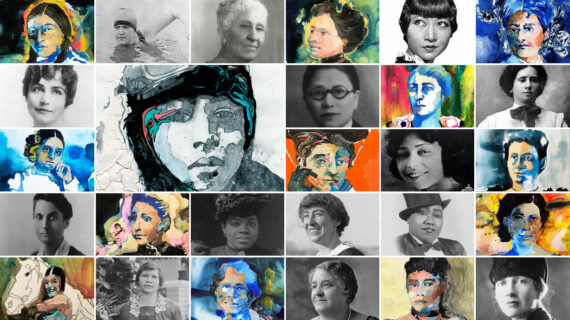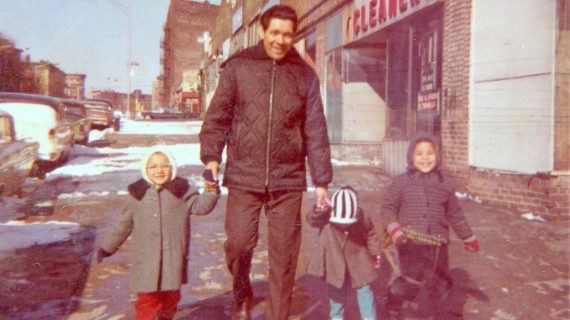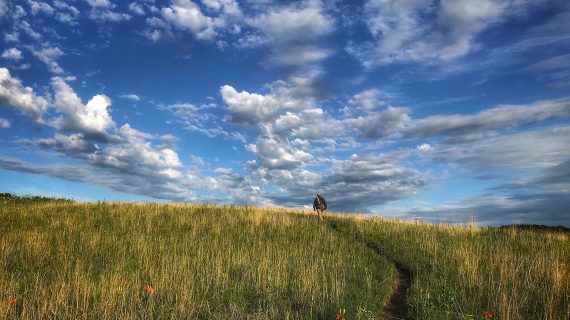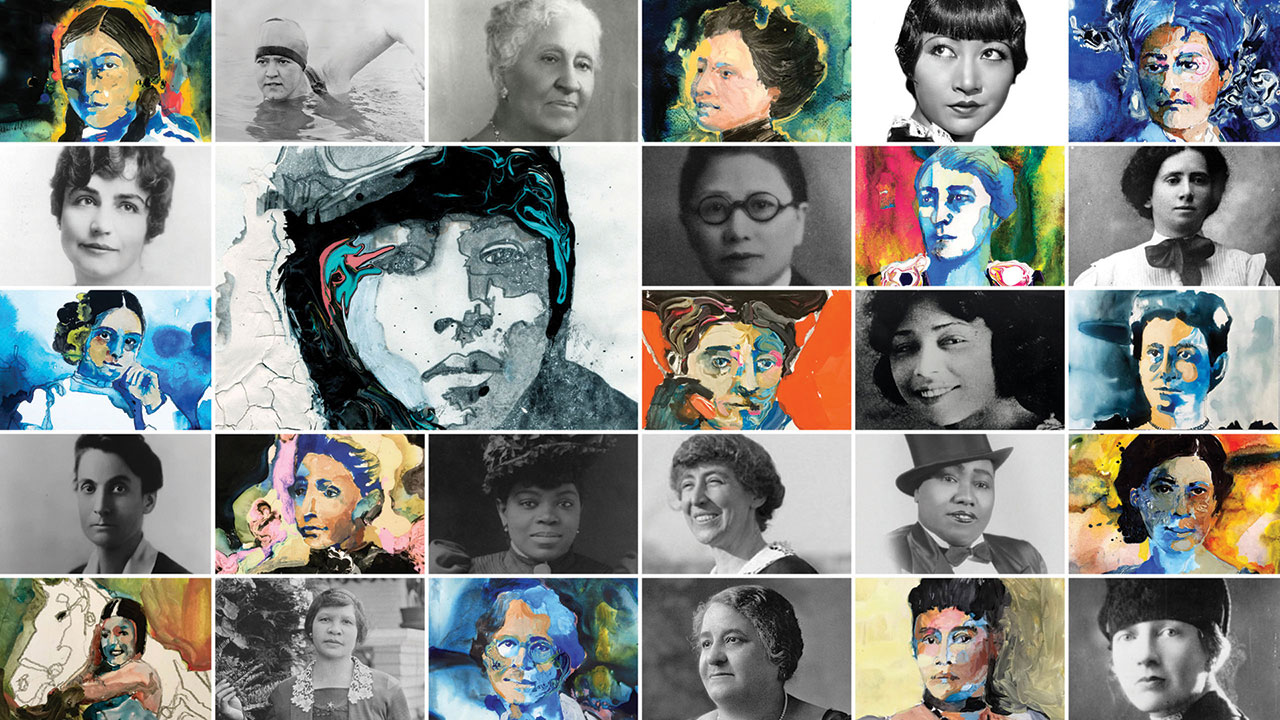– Today we are pleased to introduce Doctor Anna-Lisa Cox as part of the Wisconsin History Historical Museum’s History Sandwiched In lecture series. The opinions expressed today are those of the presenter and are not necessarily those of the Wisconsin Historical Society or the museum’s employees. Anna-Lisa Cox is an award-winning historian on the history of racism and race relations in 19th century America. Currently a Fellow at Harvard University’s Hutchins Center for African & African American Research, she also was a recent Research Associate at the Smithsonian’s National Museum of African American History and Culture where her research underpinned two major exhibits including one on black pioneers. She is also the author of “A Stronger Kinship: One Town’s Extraordinary Story of Hope and Faith.” Here today to discuss the forgotten history of America’s African American Pioneers, please join me in welcoming Anna-Lisa Cox. (audience clapping)
– Thank you. I’m really glad to be here today. I’ve just Northeastern leg of my book tour and it’s a delight to be back here in what I think of as the Northwest Territory. Which is what this space used to be right? So before I start reading, I just wanted to give a brief introduction to my book. This is basically the lost history of the nation’s first great migration. So it’s the movement of tens of thousands of free Northwest Territorial Frontier before the Civil War. And I need to stress that okay. So this is a movement that’s starting in the 1790s. Now these are not the first African descended people in this region, but they are the first African Americans to be coming into this as pioneers. So they’re interested in that pioneering project, in fort building and clearing land and establishing farms. When I started off writing this book, the general assumption was that there were maybe half a dozen at most a dozen such settlements. So far, I’ve been able to find well over 300. So these are settlements that are home to wealthy and successful African American farmers. And I want to stress if those of you who read the book and I do urge you to read it, because there’s so much in there.
And so much detail that I can’t talk about today. But the map in the front of that book is very conservative. It’s not blacksmiths, it’s not general store owners. It’s not African Americans in cities. It’s just African American land-owning farmers and their settlements okay. So actually that map should show even more people. Like the Midwest used to be so much more integrated than it is today; let me give you an example. In the state of Michigan, when Michigan did its state census in 1853, all but eight counties in that state had African American residents. Today that number has basically switched. This is an important history because not only does it unbury a lost history of this region which used to be so much more integrated. But is also is a history of backlash against African American rising. And it’s not just against African Americans. It’s against their allies as well. It’s against anyone who’s sort of pro-equality. Pro equal rights. I have named each chapter after a quote from the Declaration of Independence. Which is actually a much more revolutionary document than we often give it credence for. There were a lot of people who believed in this document in the early years of this nation. And as I point out in my book, the Northwest Territory not only was free from slavery but it had equal voting rights. Now you had to be male, you had to be over the age of 21.
You had to own property right. But it was regardless of the color of your skin. And this was very deliberate. The 1787 Northwest Territorial Ordinance is about four pages long; it’s beautifully written. I would strongly urge you to go on to the Library of Congress website take a look at it. But if any of you can find the word white in there, I will give you five bucks. ‘Cause you’re not going to find it. I’ve promised that to a lot of people and so far I’m five dollars richer. But the Northwest Territory was not alone. In 1792 when George Washington ran for president for a second term the vast majority of new American states had equal voting rights. States like Georgia had actually removed the word white from their old constitution in order to open up the vote. So what you had was a truly revolutionary period of advancement and then what I’m going to be talking about is a period of retreat. So I’m reading chapter nine which is fairly far advanced in the book. It deals with the 1850s. And the chapter is called A History of Repeated Injuries and Usurpations. 1851.
Aaron Siddells was leaving. He had been living in a rural area outside of Indianapolis. Siddells had settled on his land years earlier and after years of danger and brutal toil he and his family now lived on one of the loveliest farms in the region. He had been comfortably situated and on good terms with the local elites. The doctor being a particular friend. But the whites who had arrived after him were none too happy with his success. Some men had attacked his home. Throwing bricks through his expensive glass windows. So Aaron Siddells had shot at them using small shot that would have stung their hind parts where it hit them. The doctor may have laughingly recounted to Siddells how the men had limped into his office. But Siddells was furious. He knew his standing in the community made him safe from retaliation. But he wanted to sue the men for the damage to his house. And whites in Indiana had voted to make such action illegal.
Right was known as one’s oath. And to lose it was to lose voice. Siddells would later bitterly recount and I quote living in Indiana, I was dissatisfied with the laws of that country. Good deal of property there, but it was not safe. For any loafing white might destroy, steal. Unless a white man was by to see it, I could get no redress end quote. So even with loyal white friends, Siddells knew that Indiana’s prejudiced laws combined with the Fugitive Slave Act of 1850 put him and his family in too much danger. So he gave up on the United States and left for Canada. But the move broke his heart. As he later admitted excepting for the oppressive laws I would rather have remained in Indiana.
I left one of the most beautiful places in that country. Everybody who sees it says it’s a beautiful place. I had a two-story frame house with piazza, good stable, and every arrangement about the premises was nice and convenient, end quote. And others were making the same sacrifice that Aaron Siddells had made. Especially farmers who lived along the Ohio River in Ohio, Indiana, and Illinois. For it was all too easy for someone to cross the river from a slave state and grab them free as they were. Their bodies had not become any less evaluable and kidnappers had become bolder. And the local laws were not helping. Indeed in 1853 Illinois whites again proved their extraordinary prejudice. Ever since the passing of the new Illinois Constitution in 1848, African Americans had been forbidden from settling in the state.
And I want to stress this. As we think about borders and immigration laws. We need to remember that the first anti-immigration laws passed in this nation were passed in the Midwest by Midwestern states against African descended people. Because those African descended people were already rising and succeeding in such numbers within those states. This racism was arising in the face of black success. In 1853, it was decided that any who were caught trying to enter Illinois would be charged a massive fine as well as court costs. And if they could not pay the fine, then the local sheriff could sell them into slavery. Effectively turning the state of Illinois into a slave trading entity. Many Illinois whites were determined to make their state a place where liberty was always at risk and equality endangered. It was not surprising that African American farmers were deciding to leave.
Some chose it freely. Others with guns aimed at them. But African Americans in Indiana, Illinois, and Ohio finding their rights and freedom endangered, knew that they still had an important freedom left. The freedom of movement. The problem though was where to go. Whites in many states to the west had not put exclusion laws on their books to hamper or block African American immigration. As well as denying African Americans the right to vote. Many whites in these regions wanted no repeat of the successful African American pioneering movement that had settled the Northwest Territory states. At California’s first state convention of 1849, the white attendees decided to exclude African Americans from voting, then many pushed hard for complete exclusion of any African descended people from the new state. Citing the laws in Illinois and arguing for similar ones in California, they warned that otherwise and I quote you will find the country flooded.
The population of free Negroes. The greatest calamity that could befall California, end quote. Robert Semple of Sonoma added that he considered free African Americans, and I quote, the worst species of the population, end quote. There was something chilling about these speeches however. For they were informed by some recent tainted information. That these politicians would’ve known of. In addition to trying to model themselves along the lines of the most prejudiced Northwest Territory states, some of these politicians seemed to have been referencing the 1840 census report. Powerful enslavers had long argued that anyone of African descent was unfit for freedom. Napoleon Bonaparte’s colonial minister, Denis Decrs, had made this argument about 50 years earlier as he ordered the French military to re-enslave freed people in places like Haiti. But the Northwest Territory states were now filled with free African Americans who clearly enjoyed the taste of freedom. A fact that many influential whites did not want reported. After the 1840 census data was tabulated and reported, it was full of so many errors that both experts in the field and politicians were outraged. Their chief complaint was aimed at bizarre data seeming to show that an extraordinary number of free African Americans in the northern states, especially the northern states that had equal voting rights, were sick or insane.
John Quincy Adams who had been the nation’s sixth president and was now a representative from the state of Massachusetts pointed out and I quote him: It listed insane Negroes where no Negro population existed, end quote. In other regions, the numbers were so falsely exaggerated that there were more listed as insane than the actual number of and I quote him: Reported Negro residents, end quote. While experts at the time argued that the report was clearly fraudulent, some later historians have argued that the fact that the entire aged and infirmed population of white people were transformed into African Americans may have just been a simple transcription mistake. However these mistakes never favored people of African descent. With one of the census transcribers converting the entire white population of a hospital for the mentally ill in Massachusetts into African Americans. These inaccuracies were another attack on freedom and equality by asserting the frailty of free African Americans. They bolstered the intellectual framework for slavery.
Pro slavery politicians could not conceal their delight. The Secretary of State at the time was the notoriously prejudiced John C Calhoun who had been recently been serving as the nation’s seventh Vice President. Calhoun had long praised the virtues of slavery. Arguing that it was the best of all conditions for anyone of African descent. Despite requests to open an investigation into the 1840 census, Calhoun refused. Arguing that the results were to be expected in the northern free black population. For these were a people who could only thrive in bondage. So African American pioneering farmers worked with what they had. Good land, good skills, and if necessary, the ability to move to a new place. In the current political environment, the frontiers of the Northwest Territory and states must have still seemed their best hope. Many were moving to its edges. Mainly in Michigan and Wisconsin. Soon the African American population of those two states was growing and fast. It doubled in Wisconsin from 630 to almost 1200 between 1850 and 1860. In Michigan in that same decade, it grew from around 2500 to 6700. Despite these relatively small numbers, the impact of the successful settlement movement would’ve been immense. For many of these African American pioneers brought enough wealth and resources to become very successful farmers by 1860. And I want to be very clear here, these are just census numbers. But after the passing of the 1850 Fugitive Slave Act the census, the Federal Census, is a tricky document to deal with because it’s a federal document. So there were a lot of people of African descent in the Midwest who did not want to be counted on this document.
And some of them are not. Probably the most famous example I’ve got is John Langston, who was the first African American to be elected to political office in the United States in a free and open election. He’s living in rural Ohio on a 200 plus acre farm. He’s also a lawyer. But he is refusing to be counted in the Federal Census even though he is running for and winning political office. Because it’s a form of protest against what the federal government is doing at that time. One of the most popular areas was in Southern Michigan. In a county called Cass. There were many reasons why successful land owning African Americans would choose this county. They went far beyond the mere fact that it was farther north and thus further removed from the threats that slave raiders from the southern states could pose. African Americans coming into Cass County in the 1850s would’ve been well aware that it was already home to successful free African Americans who had founded one of Michigan’s first African American Baptist churches there in 1838. It was also home to many abolitionist minded whites, Quakers included. Who had been running a successful branch of the Underground Railroad with local African Americans. And I want to stress this. A lot of the history of the Underground Railroad has stressed the white conductors but actually many, many of these African American farmers were also conductors before there was even a railroad, right. And some of them were working with whites along the line. So there’d be a white family and then an African American family, on up. There was still ample good land in Cass County. And a strong network of African American farmers already in place. And there were schools.
Cass County had good integrated public schools despite state laws forbidding integrated education in publicly funded schools in that state. And I want to add here that in addition to the fact that every single state that was carved out of the Northwest Territory reversed the Northwest Territorial Ordinance. They didn’t make themselves slave states, some tried. But they didn’t make themselves slave states. But they did reverse that equal voting rights act. So they stole the right to vote from the African American pioneers who were already in those states. And Wisconsin did that as well. And then on top of that every single one of these states had laws in which African American pioneers were taxed for their land to build public schools that their children couldn’t attend. So it’s not only taxation without representation, it’s taxation without education, right? Which is really, really tough. It’s really tough. For years, African Americans in Cass County had petitioned the state for the right to vote in school district meetings. As well as to run for and hold office in the local school district councils. Finally in 1855, whites in governance in Michigan decided that African Americans should at least have the right to vote in their local school board elections. This fairly minor victory was definitely not a return to the full voting rights of the Northwest Ordinance. But on a national level it had a profound effect. For Michigan was one of the rare states in the 1850s moving toward African American equality and citizenship, rather than away. The African American population of Cass County practically exploded in the 1850s. By 1860 over 600 African Americans lived there. Making it one of the largest rural African American settlements in the Northwest Territory states. While Michigan was drawing most of this third wave of African American pioneers, Wisconsin also offered some hope.
True, it was still a frontier state in the 1850s. But the whites in government there still had not created black code bond laws to limit African American immigration. Of course whites in power allowed themselves to be ruled by prejudice changing the Northwest Territory voting guidelines and restricting voting rights to whites only when it became a state in 1848. But just five years later in 1853, the Wisconsin Supreme Court heard a case involving Joshua Glover who had freed himself by fleeing to Wisconsin. Aided by those working to overturn the 1850 Fugitive Slave Law, the court had ruled that law unconstitutional. However, many of the African Americans settling in that state were not refugees from enslavement. But long free people seeking a new home where they could prosper without so much prejudice. Many came up the Mississippi River from Illinois moving into the wilds of Western Wisconsin, where some were the first settlers to purchase federal land in their chosen township. Literally land deed number one. And more than African American businesses and farms were rising in the backwoods of Wisconsin.
Something else was blossoming in the wilderness. Love. Among the small group of African American land owning farmers in frontier Wisconsin in 1860, four who allowed themselves to be counted in the census were in mixed marriages. Cyrus and Mary Livingston lived in Peshtigo Township, Oconto County. And I apologize if I mess up the pronunciation. I am not a native Wisconsinite. Cyrus was an American of African descent. Born in Virginia in 1815. And Mary was a German immigrant. Together they were farming their land with Mary’s brother John Schutte who lived with them. Some of these families were astonishing in their blending. In some cases, one or both spouses had been widowed and brought children from their previous marriages with them. Mather and Emmeline Robinson were farming their land in Plymouth Township, Rock County. Like Cyrus Livingston, Mather Robinson was an African American. Born in Virginia. While Emmeline was white and from Vermont. Together they were raising their eight-year-old daughter Mary who was attending a local school. As well as Emmeline’s son William Anderson from her first marriage. Now, free people in the North had long intermarried. But as the tide of prejudice grew, it caught love in its current and tried to drown it.
A white man raping an African descended woman was one thing, as Colonel Robert Little had made clear in 1830 Cincinnati. But love between two free people that resulted in marriage was becoming increasingly hated. Even among self-professed abolitionists. And tarring and feathering was increasingly used as a weapon utilized in a war trying to enforce hate. A war to destroy any relationship that represented equality. Whether it be a white woman teaching African American children or a couple marrying. A young man and woman in Indianapolis discovered this fact in 1840, when they wed in that city. Both looked to be of European descent. But the young man happened to be of African descent as well. When his ancestry came to light a mob dragged the young couple from their home. The white wife was stripped, tarred, feathered, and ridden out of Indianapolis on a rail. Pioneer life may have been very difficult indeed. But by the 1850s nothing was as dangerous to these mixed families as other white people. But not all were leaving. Despite many African Americans leaving Illinois after the passage of the dreadful law in 1853. Despite the rising tide of violence, African Americans were still staying and organizing even in Illinois.
In 1856, they gathered in Alton, Illinois. The very town were 20 years earlier Elijah Lovejoy had been killed. On November 14 they met and read aloud a declaration of sentiment and a plan of action. It was beautifully constructed, connecting the words to the Declaration of Independence and the United States Constitution with their own additions calling on the nation’s revolutionary roots. Its first resolution read, and I quote: That all men are born free and equal. Possessing certain inalienable rights that can neither be conferred or taken away. They were man’s from the beginning before he could comprehend them. Eternal, indestructible, end quote. And they reminded the whites of Illinois, the Northwest Territory, and of the nation, and I quote: That the Constitution of the United States declares in its preamble that it was intended to establish justice. Therefore opposed to injustice. To promote domestic tranquility. Therefore opposed to domestic turmoil. To promote the general welfare. Therefore opposed to the general misery. Thank you. And I’m done. (audience clapping)
Search University Place Episodes
Related Stories from PBS Wisconsin's Blog

Donate to sign up. Activate and sign in to Passport. It's that easy to help PBS Wisconsin serve your community through media that educates, inspires, and entertains.
Make your membership gift today
Only for new users: Activate Passport using your code or email address
Already a member?
Look up my account
Need some help? Go to FAQ or visit PBS Passport Help
Need help accessing PBS Wisconsin anywhere?

Online Access | Platform & Device Access | Cable or Satellite Access | Over-The-Air Access
Visit Access Guide
Need help accessing PBS Wisconsin anywhere?

Visit Our
Live TV Access Guide
Online AccessPlatform & Device Access
Cable or Satellite Access
Over-The-Air Access
Visit Access Guide
 Passport
Passport












Follow Us